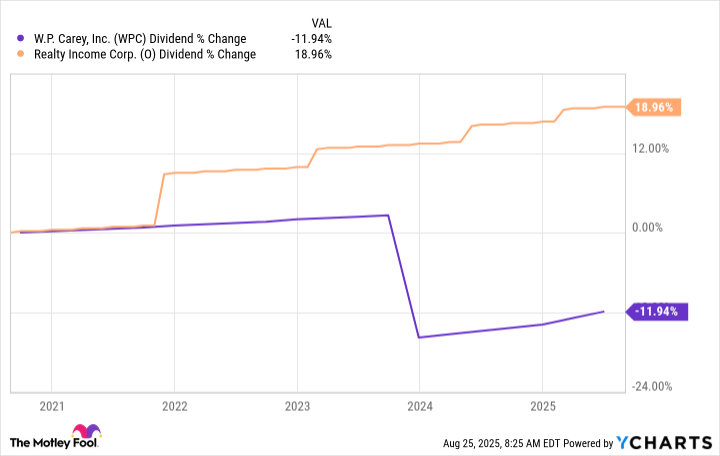
In the world of dividends, few stocks stand as monumentally as Realty Income (O), a titan in its realm. Its storied history of rewarding income investors with regularity and fortitude seems unassailable at first glance. However, such outward simplicity, of course, rarely conceals the full depth of the tale. For in the quieter shadows, less conspicuous yet no less potent, lies a rival, a smaller entity whose narrative may prove more compelling for the discerning eye. This tale is not merely of two companies, but of contrasting philosophies, different strategies, and a quiet struggle for supremacy in the world of net lease real estate investment trusts (REITs).
The Nature of Net Lease REITs: The Quiet Mastery of Capital
To the untrained observer, a net lease REIT is but a business that acquires properties, leases them to tenants, and collects rent. Yet in this simple-sounding transaction, a profound mechanism is at work-one that intertwines risk, capital, and long-term stability. Realty Income, the largest among its peers, boasts a market cap more than three times that of its nearest contender, W.P. Carey (WPC). Its empire, which spans over 16,600 properties, dwarfs W.P. Carey’s relatively modest collection of 1,600. The grandeur of its scale allows for easy access to capital markets, an advantage that others, in their smaller forms, might not share.
But let us not be fooled by the scale alone. A net lease REIT is more than the sum of its assets. At its core, it is a vehicle for financing, a mechanism wherein companies sell properties and lease them back with long-term agreements. The elegance lies in the simplicity: a tenant is secured, a property maintained with minimal oversight, and rent flows steadily, often with annual increases. Such arrangements, often likened to a quiet symphony of predictable cash flow, are the hallmark of companies like Realty Income. It seems a win for all parties involved-a mutual, if tacit, understanding of shared benefit.
Yet, as in all tales of fortune, there lies a deeper narrative. While Realty Income, with its proven consistency and vast portfolio, stands as a beacon to those seeking reliability, it is not necessarily the swiftest or most agile player on the field. A smaller rival, W.P. Carey, despite its recent struggles, may indeed be the more astute choice for those investors whose gaze is fixed on growth and adaptation to shifting tides.

W.P. Carey: The Strategic Gambit of a Smaller Rival
W.P. Carey’s story is one of calculated risk, the kind that comes not from rashness, but from an unflinching recognition of shifting sands. In 2023, it exited the office property market, a move that appeared, on the surface, a retreat from the wider world of commercial real estate. But in truth, it was an act of foresight. The office sector, beleaguered by long-term occupancy challenges, was no longer the profitable bastion it once was. By selling off this portion of its holdings, W.P. Carey freed itself from the shackles of an uncertain future. The proceeds were then channeled into industrial, warehouse, and retail properties, sectors poised for growth as reshoring trends emerge on the horizon.
W.P. Carey’s shift in focus has yet to be fully appreciated by the market, and thus, the rewards of its boldness remain largely untapped. A closer examination reveals that its portfolio now tilts heavily toward industrial and warehouse properties, sectors that, as history suggests, offer greater resilience in the face of economic shifts. These properties, larger and more specialized than their retail counterparts, are poised to benefit from the unfolding trends of global trade and manufacturing. The rent increases, once modest in retail, have been far more pronounced in these industrial sectors. W.P. Carey’s ability to leverage its smaller size for faster growth, with an adjusted funds from operations (FFO) per share increase of 6% in the first half of 2025, speaks volumes about its latent potential.
While Realty Income moves with the stately pace of a great ship, its movements are often less dramatic, less prone to sudden shifts. W.P. Carey, on the other hand, exhibits the quickness of a smaller vessel, more nimble in its maneuvers. The dividend yields of both companies-approximately 5.5%-are similar, yet W.P. Carey’s recent return to quarterly dividend increases suggests an underlying confidence, a quiet promise of higher returns in the years ahead. While Realty Income’s dividend history is impeccable, it is a company of stability rather than rapid growth. The question that confronts investors is whether stability is sufficient, or whether they seek something more: growth, adaptability, and the possibility of a brighter future.
A Dilemma for the Investor: Two Roads, Each with Its Own Truth
As the tale unfolds, the question arises: which path should the investor take? Realty Income, with its storied history and vast empire, offers security and reliability-qualities that many investors cherish. Yet its slow growth and heavy reliance on retail assets may seem less compelling when viewed through the lens of future potential. W.P. Carey, in contrast, offers a more dynamic future, albeit one shaped by recent strategic resets. It is a company in transition, poised to benefit from shifting market forces, but not without risk.
Perhaps, as in many great stories, the wisest course of action lies not in choosing one or the other, but in embracing both. The portfolios of Realty Income and W.P. Carey are complementary in nature, one rooted in retail and the other in industrial assets. For an investor, this dual approach offers both the stability of Realty Income and the growth potential of W.P. Carey-a harmony that could serve as the foundation of a prudent and forward-thinking portfolio. In such a choice, the investor finds both security and possibility, a balance that transcends the mere accumulation of wealth.
And so, dear investor, the decision lies before you: to embrace the present stability or the promise of future growth? Either path will demand wisdom, foresight, and a steady hand. May your choices be guided by both caution and ambition, for in the delicate dance of dividends, one must always be vigilant.
🌱
Read More
- Silver Rate Forecast
- Gold Rate Forecast
- Красный Октябрь акции прогноз. Цена KROT
- MSCI’s Digital Asset Dilemma: A Tech Wrench in the Works!
- Dogecoin’s Big Yawn: Musk’s X Money Launch Leaves Market Unimpressed 🐕💸
- Bitcoin’s Ballet: Will the Bull Pirouette or Stumble? 💃🐂
- Guardian Wealth Doubles Down on LKQ Stock With $1.8 Million Purchase
- Binance and Botim Money Join Forces: Crypto in the UAE Gets a Boost-Or Does It? 🚀
- Twenty One Capital’s NYSE debut sees 20% fall – What scared investors?
- Monster Hunter Stories 3: Twisted Reflection gets a new Habitat Restoration Trailer
2025-08-28 12:57